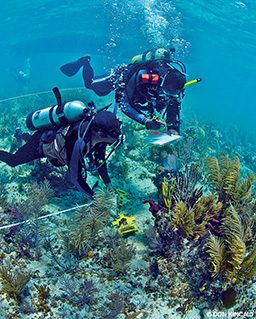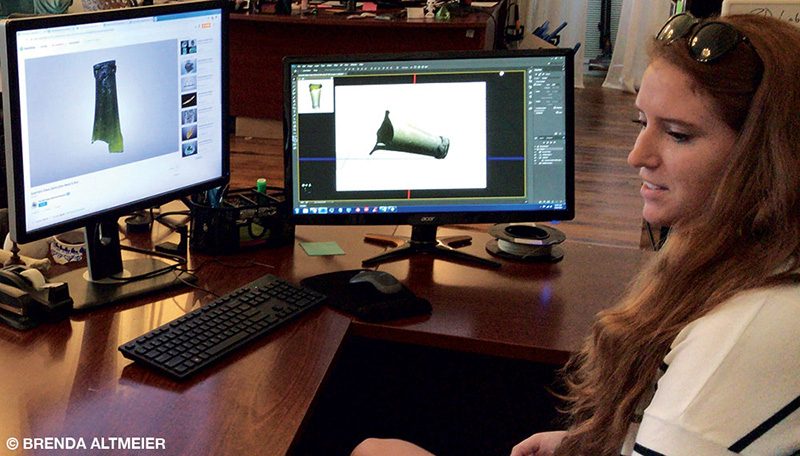Volunteer archaeologists help uncover history beneath the waves.
When has diving ever been without a purpose? (Have you ever not thought about diving with a purpose?) Most divers focus on their own personal reasons for diving, usually driven by the visceral experience of breaking away from terra firma to a place where humans don’t dominate the landscape. Your time is limited on earth, but even more so underwater, making the experience a little more serious.
As humans, we desire to test our strength and expand our horizons. Many divers find their horizon along 100 miles of ancient coral reefs in the Florida Keys, a once-desolate island chain spreading southwest from the tip of mainland Florida. Centuries of travel, discovery, inhabitation and development have created the Florida Keys as we know it today. Residents and visitors who once focused on fishing and tropical weather now find pleasure in the fathoms awaiting their arrival.

Over the past 15 years, divers from the nonprofit organization Diving with a Purpose (DWP) have gone beyond the pursuit of personal experiences. By donning 60 pounds of gear, grabbing tape measures and slates and plunging into the sea, they began seeking answers to questions once only pursued primarily by maritime archaeologists.
DWP started as a partnership between members of the National Association of Black Scuba Divers and Biscayne National Park in 2004. News of a lost slave ship named Guerrero off the coast of the Keys sparked a fire in the heart of DWP’s founding director Ken Stewart, who relentlessly pursued a way to find out more. His quest led him to Biscayne National Park and Brenda Lanzendorf, a maritime archaeologist who served with the National Park Service until her untimely death in 2008. Lazendorf’s willingness to help cultivate the enthusiastic dive group provided the confidence they needed to organize and start planning annual visits to the park, where they trained new advocates and participated in archaeological projects under Lanzendorf’s direction. As DWP flourished, so did its membership and participation, which eventually expanded beyond the national park.
Today DWP is a community-focused organization that provides maritime archaeology and ocean conservation education, training, certification and field experiences for adults and youth. Of special concern are the protection, documentation and interpretation of African slave-trade shipwrecks and the history and culture of African-Americans who provided labor and expertise for U.S. maritime enterprises.
In 2009, DWP began an official collaboration with the National Oceanic and Atmospheric Administration (NOAA) Office of National Marine Sanctuaries. Since the start of this partnership, DWP has supported sanctuaries through collaborative projects and focused investigations on historical sites across the country. A timeline of important projects follows.
Florida Keys National Marine Sanctuary (2012, 2014, 2015)
Elbow Reef, Key Largo
The steamship Hannah M. Bell (aka “Mike’s wreck”), built by Ropner and Son in Stockton-On-Tees, England, launched into the Tees River on March 20, 1893. The vessel had two triple-expansion engines that generated 1,000 horsepower from two boilers. The ship made transatlantic trips between European ports, the U.S. East Coast and Gulf Coast, and Caribbean and South American ports while carrying a variety of bulk cargo. It ran aground at Elbow Reef on April 4, 1911, and became a total loss after salvagers were unable to recover any cargo. NOAA staff with the support of DWP organized three projects, which resulted in a detailed site map of the 315-foot shipwreck that identified features of the ship such as its framing pattern, bulkhead, deck beams and riveted construction.
State of Michigan (2015)
Lake Huron, Alpena, Michigan
A P-39Q Airacobra plane was lost over Lake Huron on April 11, 1941, during a training mission from Michigan’s Selfridge Field near Detroit. The plane was operated by Tuskegee Airman 2nd Lieutenant Frank H. Moody, one of the first African-American military aviators in the U.S. Armed Forces. During World War II, African-Americans were subject to Jim Crow laws that enforced racial segregation in the southern United States. These brave men dedicated their lives to fighting for the U.S. even though the American military was racially segregated. Lt. Moody’s plane was found April 11, 2014, 70 years to the day of his fatal accident. In a 2015 joint effort with the state of Michigan, NOAA and local law enforcement, DWP divers descended on the lost plane with tape measures and writing slates to document this important piece of history.

Florida Keys National Marine Sanctuary (2016, 2017)
Elbow Reef, Key Largo
The Scottish steamship Acorn was built in 1880 in the Thistle Works shipyard in Paisley on the White Cart Water, a tributary of the River Clyde. The Campbell and Co. vessel carried cargo around the Atlantic but wrecked in 1885 at Elbow Reef, just south of the Hannah M. Bell. NOAA staff, with the support of DWP, created a detailed site map of the 165-foot steamship that now sits in 20 feet of water. The site map reveals the vessel’s propeller blades and remains of the ship’s boiler.
Florida Keys National Marine Sanctuary (2018)
Molasses Reef, Key Largo
First launched into the Adriatic Sea in 1884, the Slobodna was a 170-foot composite-built ship with iron framing and wood planking — a transitional construction style before all-steel vessels predominated. Hoping to profit on the European demand for cotton, Slobodna’s owner set off to America with the dream of a large payday. The vessel reached the New Orleans Cotton Exchange in Louisiana, where its hold was jammed with 4,500 bales of cotton. The heavily laden sailing vessel left New Orleans hoping to beat competitors to the markets in the Baltic. As it sailed past Key Largo, wind and tide brought it too close to Molasses Reef, where it ran aground on March 16, 1887.

Wrecking vessels, which were somewhat equivalent to modern-day on-water assistance services, salvaged much of the cotton cargo but could not save the ship. The story educates us about how the Florida Keys fit within the maritime history of the Atlantic. Ships such as Slobodna connected European manufacturing centers to American agricultural export markets in the South, contributing to that region’s economic revival. Similarly, the sale of Slobodna’s salvaged cotton brought economic prosperity to Key West.
DWP’s dedication and volunteerism is not only self-gratifying but also serves the greater community by endeavoring to engender appreciation for what awaits underwater explorers and how we can learn from the experiences of others. Large and complex sites such as the Hannah M. Bell, Acorn and Slobodna require hundreds of hours of tedious and time-consuming dives to measure and document the areas, with even more hours spent on the enormous undertaking of postdive data transfer.
While DWP has wholeheartedly supported a wide array of projects over the years, the Guerrero continues to be one of its prime objectives. Since 2003 DWP, sanctuary staff and Corey Malcom, director of archaeology for the Mel Fisher Maritime Heritage Society, have continued to keep alive the Guerrero story and investigation.

Since 2005 more than 500 divers have participated in DWP projects in six countries. Their contributions total 1,800 hours of global, community, environmental and history-focused public projects, which are part of a featured exhibit titled “DWP 15-Year Odyssey: Restoring Our Oceans, Preserving Our Heritage” at the History of Diving Museum in Islamorada, Florida, through December 31, 2019.
Leaving a legacy gives DWP a purposeful mission. The hope is that through advocacy for underwater cultural heritage preservation, local Florida Keys communities and visitors alike will recognize Florida Keys shipwrecks for the unique experiences they offer.
Diving with a Purpose is a journey shared by all of us. DWP’s collective body of work is the legacy and human record of our ever-increasing need to have purpose above and below the waves.
Explore More
Learn more about Diving with a Purpose in these videos.
© Alert Diver — Q4 2019